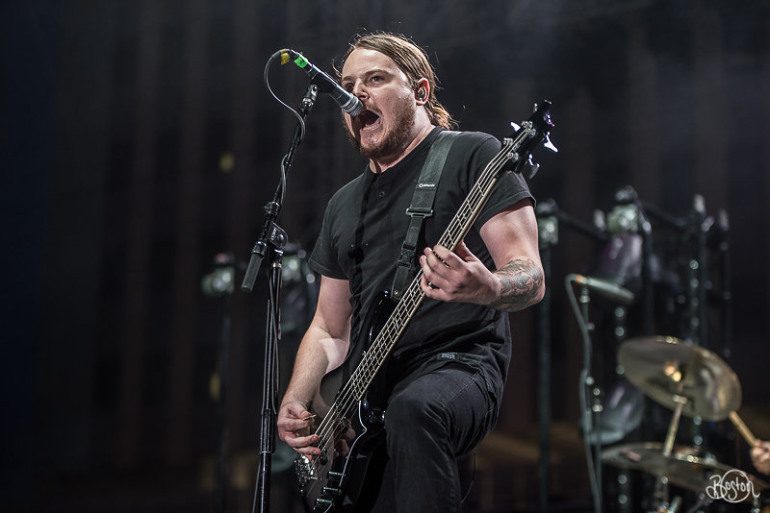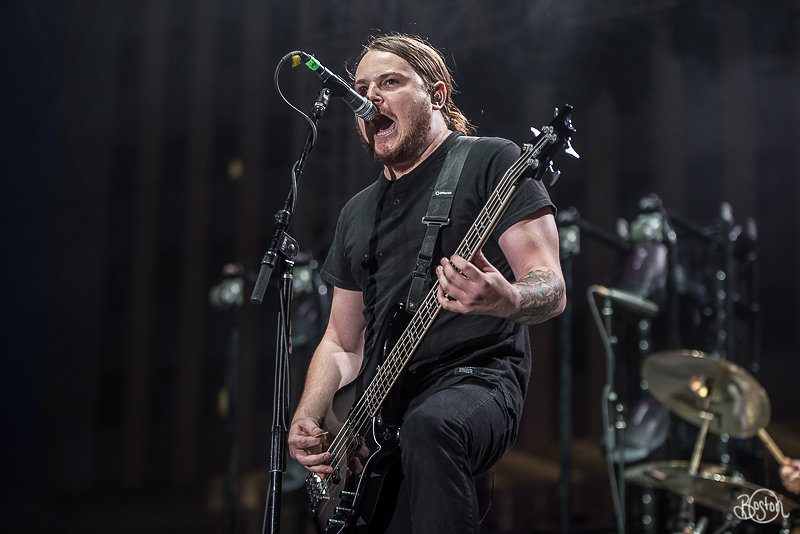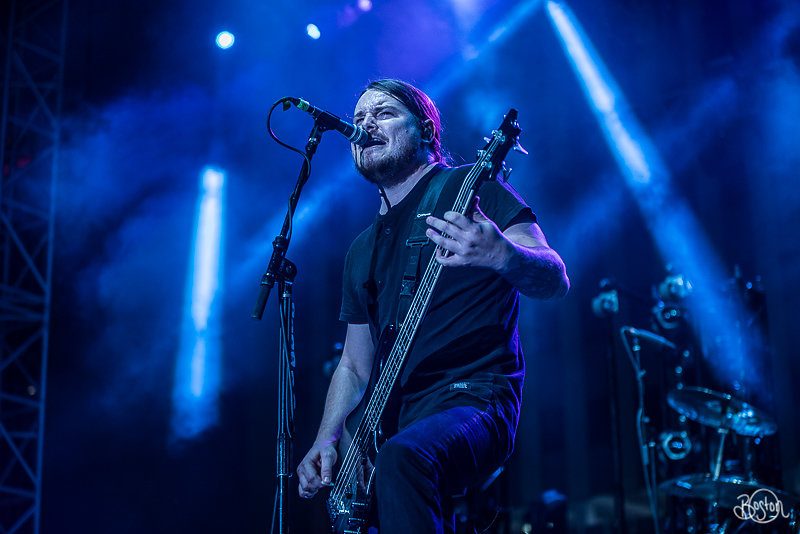

Of Mice & Men’s latests album, Tether, is a relatable creation of the emotions all too well known to the world as of late. The record is self-produced and highlights the more creative freedom of sound design elements compared to the previous album, Echo. Frontman, Aaron Pauley, shared with mxdwn specific inspirations, the development and ideas behind their song making process. With many tours dates scheduled for 2024, hearing Tether live will undoubtedly be an exciting and meaningful experience for fans across the globe.
mxdwn: Hi, my name is Eve Pierpont and I’m the editor for mxdwn’s music features section. I’m here today with Aaron Pauley from Of Mice & Men. Hi Aaron. How are you?
Aaron Pauley: I’m good. How you doing?
mxdwn: Pretty good. So, Tether‘s lyrics focus on how art can help cope with feelings like anxiety, isolation and anguish. Where did the idea come from to write the lyrics with this in mind? How has art helped you cope with such feelings?
AP: I think that was sort of a culmination of a bunch of different losses and tragedies and stuff happening in our lives – sort of collectively as a band, individually and whatnot. I think that was sort of, you know… being there for your family was something that everybody had to do in some capacity or another. It seemed like at different times and in different struggles, things like that. I think it was just very prevalent in everybody’s lives so when we get together and start creating stuff, it’s usually… it’s a way of us expressing ourselves. Sort of letting out and materializing whatever we’re going through into something that we can maybe analyze and understand a little bit. So, I think that’s probably where that came from.
mxdwn: Interesting. I love that. It’s definitely very relevant, very true. How has it been to change headspaces a little bit while producing music, going from more of a live mindset to one that is more about the listener at home?
AP: I don’t know. It’s interesting because we just got off tour, so I feel like right now maybe I’m still in that mindset, but we’re starting to work on some new ideas and whatnot here and there. I don’t know. You know, it’s something that I feel like if you don’t think too heavily about one way or the other, you can just enjoy the act of creating while you’re creating and not necessarily think of what it’s gotta do after the fact. You can kind of stay more focused on it, I guess.


Photographer Credit: Boston Lynn Schulz
mxdwn: Yeah, definitely. Can you share any of those ideas that you have going on that you were just referencing?
AP: Oh, the new ideas? No. {laughs} All that stuff is still being worked on. Very infant, I guess.
mxdwn: I understand, just had to ask. What was it like to self-produce Tether?
AP: It was a lot of fun. It was a fair amount of pressure and a lot of work. I think doing something cohesive like that, you know, we produced the album before Echo, but we released that and we wrote it and produced it in EPs, so doing an album is like doing, you know, the three EPs all at once basically. It definitely all taught us, I think, lessons in like organization and {laughs} that was probably a big one. But no, it’s a lot of fun and we’re blessed to have worked with the producers that we’ve worked with in the past. We were, at the time, just sponges of knowledge and wanting to learn everything we could. Now, since the post COVID era, when everything was shut down and the studio we used to go to down here like sold and closed… I think it’s a lot of fun. It puts a lot of the control in our hands and at the same time there’s a lot of responsibility in buckling down, really honing in on our decision making because there isn’t an outside element telling us like, okay, yes or no. So it’s like we have to decide yes or no. A lot of times, creatively you can just work on stuff for a really long time without deciding things.



Photographer Credit: Mehreen Rizvi
mxdwn: Yeah, I could definitely see that. Was there anything unique or different employed while creating this record compared to working on Echo?
AP: I’m trying to think. Not really. I think there was a little bit more, we felt a little bit more creative freedom. Especially in the sound design elements and things like that. With this record, after doing Echo, because Echo had a lot of those elements and we felt like it introduced them into a way that wasn’t. I suppose it wasn’t jarring enough for like, fans to talk to us about it, about it being a problem. We sort of felt, I guess a little more confident and just excited by that sort of element of it. So, that was fun to dabble in.
mxdwn: Gotcha. Yeah. That’s super interesting. How did you map out the order of the songs for Tether?
AP: We knew the first and last song “Zephyros” and “Integration” were, I think, the two songs that were finished first. I say finished in terms of like, being written pieces, not necessarily like final recordings or whatnot. I think that sort of outlined it and then as we were coming up with new ideas and as were sort of honing stuff in and saying like, yes, this is going to go on it, no, this isn’t going to go on it, that sort of starts to fall into place. Then ultimately we had a track listing that was, I think basically exactly the track listing as it is now, except “Into The Sun” and “Indigo” were flip-flop places. I think it was Sal at our label that was like, hey, this would be interesting if we swapped these two, and I thought like, oh, that is kind of interesting, and it’s sort of interesting in the storytelling aspect of it, I guess, too. If that still exists, if people still listen to albums for that {laughs}.
mxdwn: Yeah, right. I know what you mean {laughs}
AP: But, no, so it’s sort of an afterthought I guess. It’s super important, but it’s definitely something that happens once all the songs are finished and you can kind of dabble around with it, you know?
mxdwn: Totally. I’ve heard other people say that very similar thing before. So, then kind of going off what you said about “Zephyros,” I was going to say it is a great closing song with a sort of like ambient ethereal feel in some parts, if that makes sense.
AP: Yeah.


Photographer Credit: Boston Lynn Schulz
mxdwn: Where did the decision come from to include those parts and have that mixed in?
AP: Well, so what’s actually funny, that song existed for a while and didn’t have any of the synths stuff, and it was cool. It was definitely its own vibe, but as more songs are being done and developed, we definitely start to see where it’s lackluster in certain places, you know, as everything starts to get more built up and polished, you start going back to the first ideas and you’re like, oh, maybe we have to bring these up to par with the new ideas, and we were just like messing around on Zoom, pulling up random synthesizers or whatnot. I was just sitting on a keyboard dabbling around on keys, like sitting here, and we got on that patch with those first sort of notes that are in the intro and then were like, whoa, that’s really cool because it’s just a whole different vibe. It’s something that’s kind of more linear. So, as stuff is going on in the song, it feels sort of like it’s floating around to this sort of central synthy element that doesn’t really go anywhere, which I guess is sort of comforting, like a comforting musical element or whatever, and then the actual melody for the synth line I took from “Pure Imagination,” “Willy Wonka,” dun-dun-dun dun-dun-dun dun-dun-dun-do-do-do, basically just took those notes and then used them in our song {laughs}.


Photographer Credit: Mehreen Rizvi
mxdwn: That’s awesome. I love that. That’s great. Yeah, I really enjoyed that. Can you share the creative process behind “Castaway?”
AP: I’m trying to think. I’m trying to think back that far.
mxdwn: I know.
AP: It’s funny because it’s like, yeah, we were probably nearly finishing around this time last year, like finishing the album. Which is crazy because we released it in October, so we like sit on it all year. I think with “Castaway,” that was a song that Alan had a demo for, and it was just like a very obvious, straightforward, and I say that, but it was for us, like a very obvious, straightforward kind of like rock song – felt good, sounded good, it had the riffs, it sort of had all the elements that we look for. So, we like stockpiled it because, you know, there’s a part of making records, about thinking of things artistically. Then there’s also a part of thinking things…like from a more utilitarian point of view of like, okay, do we have songs that sort of service these different listener checklists? You know, reasons why people might like our band, things like that. So, it’s like having, I don’t know…I just lost my train of thought. I just trailed off, started thinking about checklists and I saw a big checklist in my brain and just went off the cliff right there.
{both laugh}
mxdwn: That’s okay. I totally understand. It happens. Where did the decision come from to release “Warpaint” first and then “Castaway” and “Indigo” as singles?
AP: Ooh, so the label {laughs}, long story short is the label. Basically we, with our input of course, but basically like they have A&Rs there that sit and listen to the record once we’ve turned it in and they say, hey, based on this and based on what our radio team is thinking, here are what we feel like are the singles and here’s what we feel like is the best order to put stuff out to peak interest and, I guess, like maintain attention spans while you’re dropping music and dropping an album. Yeah, so basically like with discussion amongst everybody, ultimately the label has the final say in what’s released when. We felt like “Warpaint” was a good song because it sort of bridged the gap between some of the heavier stuff on Echo and then some of the weirder places where Tether ends up, I think is an album.



Photographer Credit: Mehreen Rizvi
mxdwn: Yeah, for sure. I can definitely see that, and definitely get that answer, the label, I’ve noticed is a common thread amongst the singles that are, you know, put out for albums.
{both laugh}
AP: Generally, because ultimately it’s their call on release and whatnot.
mxdwn: Gotcha.
AP: But generally speaking, you know, I think labels that are worth their weight in salt, I think are ones that trust their artists, you know?
mxdwn: Mm-Hmm. For sure. So, the song “Tether” speaks to being someone’s tether, along with it being the title of the album. Can you tell me a little bit about the background of that and how did it come to be titled “Tether” and what does that kind of mean to you?
AP: Um, yeah, so that song kind of came about from {laughs} actually, initially it came about from messing around with a bunch of different samples of things that Tino had made. Where they were basically like here’s some just random loop ideas or things like that, and sort of dragging them out of a Dropbox into Logic and just sort of creating the loop out of old things and recycling ideas that don’t end up becoming songs. You can take a piano part from it or something, you know, so I think that’s initially where it started. I don’t know, to me the song kind of sounded like, I just kept envisioning like “Deadliest Catch” or something. I kept imagining a harbor, while listening to it you know? And so I think the word harbor kept jumping out to me, so from there, “head into the harbor,” and then sort of developing the song from there. It’s really weird. It’s really weird to talk about because I don’t really feel like I ever write anything, like I sit down and think of it. It’s like sometimes ideas are just sort of beamed to you and your brain just latches onto something and I’ll sit and I’ll work very diligently on it, and then at the end be like, whoa, where’d that come from?
mxdwn: No, I get that.
AP: It’s a little esoteric, but…


Photographer Credit: Mehreen Rizzi
mxdwn: Yeah, no, for sure. I can see that definitely being a way to go about it. What was it like to create and record “Indigo?”
AP: Oh, that song almost didn’t make the record.
mxdwn: Oh, really?
AP: Only because honestly, that was the last one I did and finished and had lyrics and vocals for. Because initially, I was sort of approaching the song like I would most songs, which is to say there’s one vocalist doing one vocal line or like one sort of main central thing, you know? There’s always different layers in things, but there’s usually just like one thing to follow, and in “Indigo,” in the chorus it blossoms and there’s, I think 10 or 11 different vocal lines happening at the same time. So before that was in there, and before the lyric was what it was, it went through two or three different versions. I just wasn’t super happy with any of it. I was just sort of messing around with it one day where I did the chorus for it and I was like, oh, I actually really like this, and sort of metaphorically what it represents to have this different range of vocalizations from like very soft high vocals that are meant to sound pretty, and screaming, it’s all happening sort of at the same time. Yeah, I don’t know. It took a long time for me to be happy with my performance on it because I feel like my job is to not get in the way of the music, because the four of us work on the music together and once we’re super happy with it, it’s like the last thing I want to do is become less happy with it because of me {laughs}.
mxdwn: No, totally understandable {laughs}.
AP: So, there’s a lot of times where it’s like, don’t get in the way of it, find something that sort of compliments it lyrically and melodically, but don’t make it about you and don’t get in the way. Those are usually my two rules.
All photos by Mehreen Rizvi
